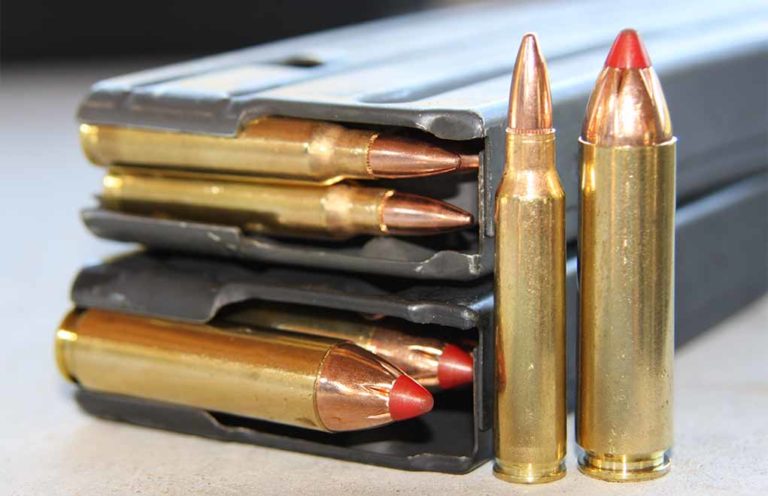
OK, you want to put the hurt to something, with a heavy bullet moving along at a pretty high velocity? The .450 Bushmaster to the rescue.
Why The .450 Bushmaster Remains A Top Big Bore Option:
- Its genesis is from Col Jeff Cooper's concept of a thumper: a large-bore semi-auto cartridge capable of one-shot kills on big-game animals.
- A necked-up .283 Winchester serves as the Bushmaster's parent case, providing reasonable capacity.
- At the muzzle, the cartridge can pitch a 250-grain bullet 2,214 fps.
- Not a true straight-walled case, the Bushmaster tapers .20 of an inch from base to mouth—this facilitates smoother feeding.
- Completely compatible with the AR-15, the rifle requires a simple upper swap to convert over.
When I first saw it, at the 2007 SHOT Show, the cartridge was so new the samples they had for us to shoot didn’t even have a headstamp on them. The bases of the cartridges, where there would have otherwise been a headstamp, were blank, as if they had been made for some super-secret CIA plan in a foreign country.
Nope, not the case. They just hadn’t gotten around to making the brass with headstamps, that’s how new it was. So new, we gun writers only got to fire a few rounds each, we couldn’t snag loaded ammo for samples to write about, and each empty was tracked as it ejected and was picked up. Yep, that’s how you can tell a cartridge is 15 minutes out of its R&D cycle.
In all fairness, the SHOT Show is when the SHOT Show is. They are not going to change anything about it, especially the dates, to accommodate a manufacturer, any manufacturer, no way. So, if your product is coming off the line just in time to pack it up and ship it to the show, that’s what you do. Because if you don’t, it is next year for your next opportunity to get your new product in front of a huge group of gun writers, the next SHOT Show.
Not The First “Thumper”
The original cartridge was designed by Tim LeGendre of LeMag Firearms. The idea was simple: produce a hard-hitting cartridge in a compact form, one that was a real crusher at close range. The result, the .45 Professional. The impetus came from the late Jeff Cooper, who called such an approach the “thumper.”
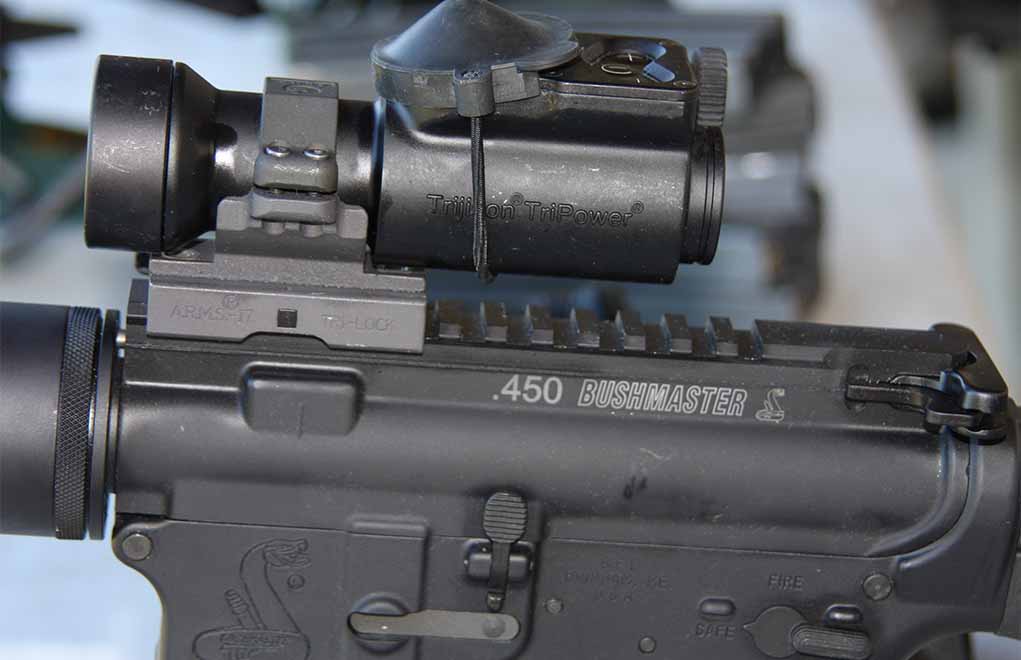
It was not new, in that there had already been lightweight carbines chambered in .44 Magnum, lever-actions and self-loaders, and there was even a short-lived run of M1 carbines rebuilt in .45 Winchester Magnum. I had an opportunity to shoot one of those particular specialties several decades ago. Once I had had a chance to inspect the sample carbine, and see how much steel had to be removed to fit the .45 case into the M1 receiver and barrel, I declined the invitation.
But by fitting that sort of a cartridge into an AR-15 receiver, the approach has a lot more strength.
.450 Bushmaster Design
The starting point for the .450 Bushmaster is the .284 Winchester case. A magnum in performance, the .284 does not have a belt, like so many of the belted magnums do. The lack of a belt, and the rebated rim, make it reasonably adaptable to standard-length bolt-action rifles, and those with standard (i.e. .473-inch diameter) bolt faces. The idea was to get .270 Winchester or .280 Remington out of a short-action rifle, instead of the standard-length actions those cartridges (based on the .30-06) required.
It might have worked, but Winchester intended it to be in, and introduced it in, the Model 100 and the Model 88. The 100 was a self-loading rifle, and the 88 was the lever-action version of the 100. Both duds, and both sought out by the few who wanted them, chambered in .308 or something with an even bigger bore.
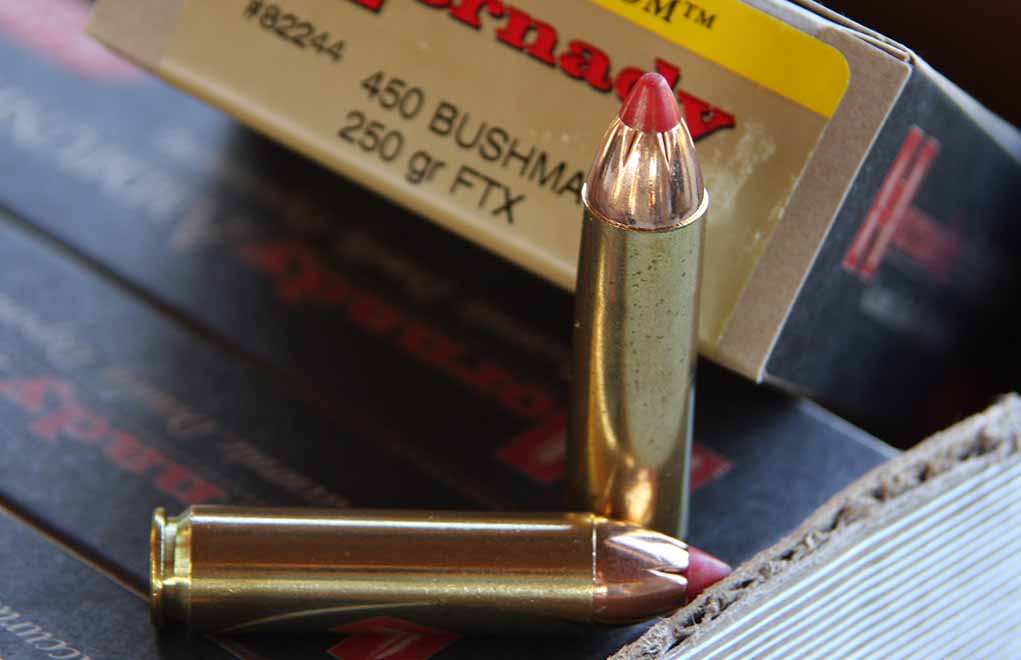
Had Winchester introduced it in something like a lightweight Model 70 bolt-action, meant as a mountain rifle, it might have had a chance. But with two strikes against it, it faded away.
But as a parent cartridge for the big thumper, it was perfect. So, back to the .450 Bushmaster.
Initially loaded by Hornady, the company adjusted the case length to accommodate its new Flex-Tip bullet and AR-15 magazines. This bullet is one with a flexible polymer tip, not a hard one, as is used on other rifle bullets. The soft tip allows for the bullet to be used in lever-action rifles, where the bullet tip will rest against the primer of the cartridge ahead of it. Hornady had a great idea, and a great bullet, but it needed the case to be a specific length to fit and feed. No problem.
Go Big!:
- Five Top Big-Bore AR and Cartridge Options
- Big-Bore AR Evolution Is Larger Than Life
- Choosing A Big-Bore Cartridge And Rifle
- Finding The Right Big-Bore Rifle Optic
The bullet also, because of the polymer tip, can have a more-pointed profile. I wouldn’t exactly call it a spire point, because you might have a mental image of a bullet much longer than the Flex-Tip is in this instance. However, the end result still improves downrange performance. The BC of the Flex-Tip used in the .450 Bushmaster is .175. Yes, it is miserable compared to the X-ELD Match 6.5, with a BC in the .600s. But you have to compare like to like. And the closest comparison to this would be a 250-grain flat-pointed .452-caliber bullet, and the nearest I can come up with as a comparison has a BC of .146. That’s 20 percent better for the Flex-Tip.
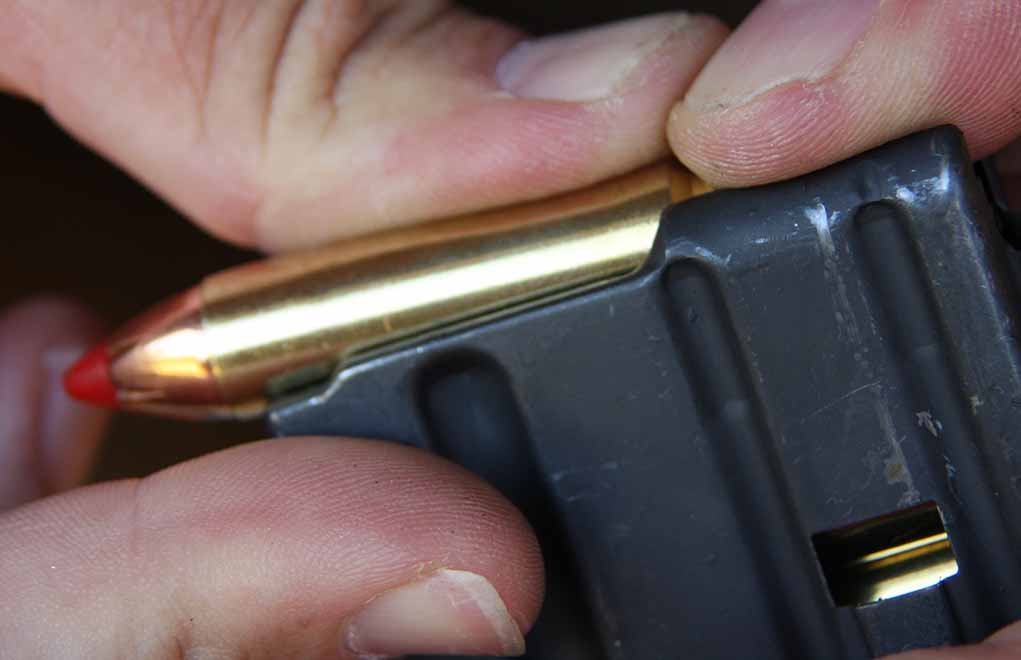
The end result is a real thumper. In an earlier age, it would have been called an express cartridge. It is a .452 bullet of 250 grains, going just over 2,200 fps. A century and more ago, the British hunted all over the world with bolt action and double rifles, with the same ballistics. No Flex-Tip for them, however.
Hunting The .450 Bushmaster
As a hunting cartridge in areas where a straight-walled cartridge is required, the .450 Bushmaster has been the choice. It does have recoil, however. The Power Factor, which is not a measure used by DNR for hunting purposes, but does correlate pretty closely to felt recoil, has the .450 Bushmaster at a 550PF. That’s compared to a .44 Magnum, which can produce a PF between 280 and 330, and a 12-gauge slug, which can crank up a 700PF. I might be convinced to shoot a .44 magnum carbine that weighs a mere seven or eight pounds with ammo, sling and scope on board, but no way am I shooting a 12-gauge slug gun of similar weight. The .450 Bushmaster can recoil enough to create a flinch if you are not careful. The bright spot here is that it is easy to find a .450 Bushmaster that has a barrel threaded at the muzzle, and thus you can install a muzzle brake to dampen its enthusiasm.
The velocity is generated by a healthy chamber pressure, at 38,500 PSI max. The pressure limit is probably there as a result of the strength limit of the AR-15, but I have to think that even if the rifle could handle more pressure, more velocity would be too much of a good thing. I mean, an eight-pound AR recoils briskly enough with a 250-grain bullet at 2,200 fps. If you were to add another couple of hundred feet per second to that, who could stand to shoot it? Even with a muzzle brake, a 250 at 2,200 is sharp enough.
This is definitely an instance when you will want to swap out the mil-spec buttstock for something with a rubber pad on it. You won’t find something with a Sorbothane pad, like the 12-gauge slug gun can come with, but you can find a non-slip buttstock. Even a small amount of rubber will make shooting the Bushmaster more fun than the hard plastic or aluminum of a mil-spec stock.
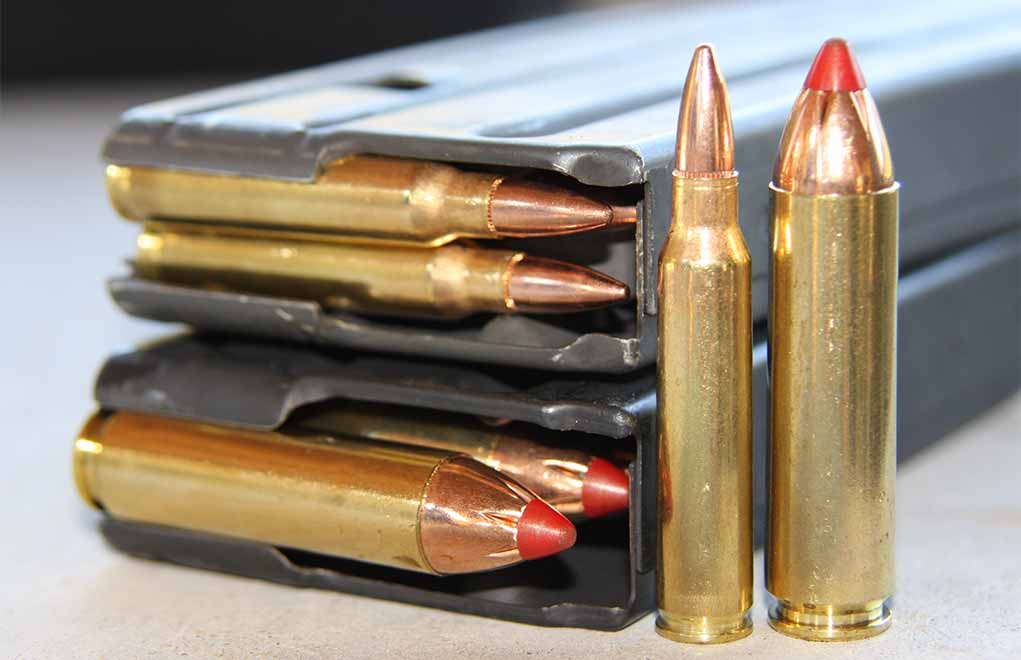
The width of the case, at an even half-inch (.500 at the base, tapering down to .480 at the case mouth) means there is no chance whatsoever of it being a double-stack in an AR-15 magazine. No, magazines are single-stack only, which means you have a few choices. An otherwise 10-round magazine will hold four rounds of .450 Bushmaster. A Vietnam-era 20-round magazine will hold nine rounds, and a 30-round magazine will hold 12 or 13. You’d think it would be the same for all, but some I’ve tried will only hold 12. That’s life.
This makes it simple for those who are planning on hunting with a .450 Bushmaster. You simply use any reliable 10-shot magazine, because it will only hold four rounds, and that is fine with DNR across the country. Well, except for those jurisdictions where four shots in a magazine are viewed with suspicion. OK, I’m being a bit alarmist, perhaps, but we can certainly understand that even if the magazines are OK, the AR-15 they would otherwise fit are not going to be allowed in some locales. Welcome to the 21st century.
Oh, and back a paragraph? Strictly speaking, if the case is .500 at the base, and .480 at the mouth, it isn’t a straight-walled case. But it does not have a visible neck, unlike, say, the .458 SOCOM (more about that in a bit) and the DNR can just overlook the minor taper. Which they do.
The rim diameter is .473, the standard American rifle case rim, which started with the .30-06 (actually, the .30-03, but who ever heard of that one?) and selected so rifle makers who were making bolt-action rifles for the cartridge could use the standard bolt face dimensions they were using for other cartridges. That’s one thing you have to consider if you are designing a new cartridge; what steps will the firearms makers have to undertake, to chamber their products in your new cartridge? Using a standard case rim diameter makes it easier for them, and more likely they will say “Yes” when customers ask.
Bushmaster Conversion
To make an AR-15 in .450 Bushmaster (besides the obvious, buy one) you need a .450 Bushmaster barrel, a bolt for same and magazines. Yes, the magazines should feed reliably, and if you have some, certainly try them. But if you are like any other .450 owner I have talked to, you will find some work and some don’t, and you’ll be sorting and marking your magazines.
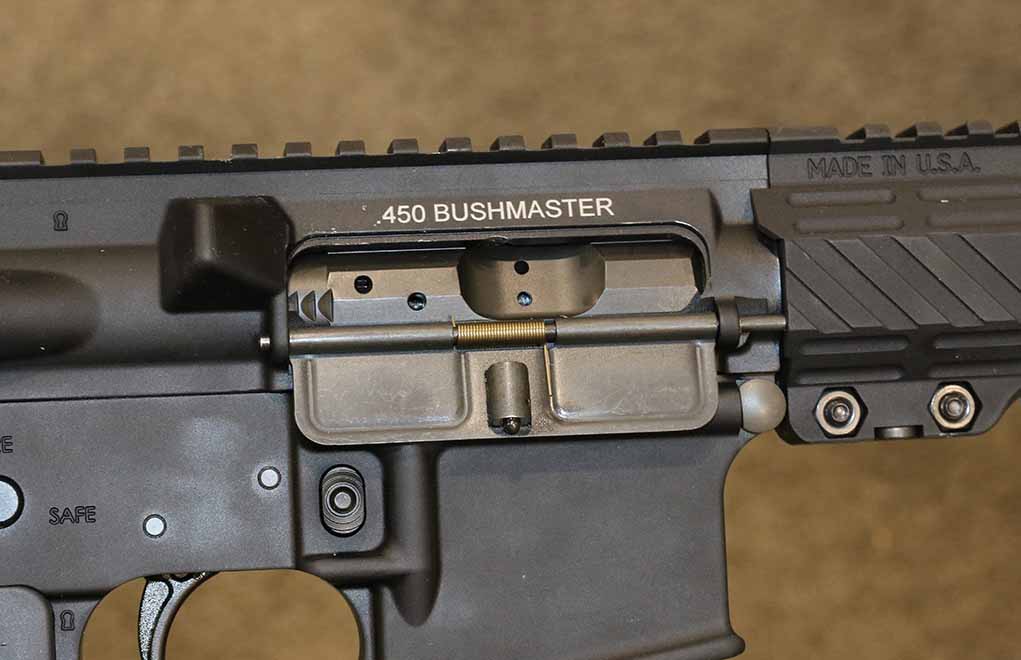
Oh, and while the recoil is going to be tough on you, it is going to be just as, or even more, tough on scopes. So do not go cheap on mounts, and don’t be surprised if your low-cost scope dies in a short while.
Editor's Note: This article is an excerpt from Cartridges of the AR-15, available at GunDigestStore.com.

Next Step: Get your FREE Printable Target Pack
Enhance your shooting precision with our 62 MOA Targets, perfect for rifles and handguns. Crafted in collaboration with Storm Tactical for accuracy and versatility.
Subscribe to the Gun Digest email newsletter and get your downloadable target pack sent straight to your inbox. Stay updated with the latest firearms info in the industry.

![Best Concealed Carry Guns In 2025 [Field Tested] Wilson Combat EDC X9S 1](https://gundigest.com/wp-content/uploads/Wilson-Combat-EDC-X9S-1-324x160.jpg)


![Best 9mm Carbine: Affordable PCCs [Tested] Ruger Carbine Shooting](https://gundigest.com/wp-content/uploads/Ruger-Carbine-Shooting-100x70.jpg)
![Best AR-15: Top Options Available Today [Field Tested] Harrington and Richardson PSA XM177E2 feature](https://gundigest.com/wp-content/uploads/Harrington-and-Richardson-PSA-XM177E2-feature-100x70.jpg)
